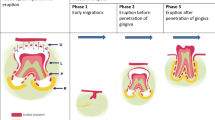Abstract
Background
This case report describes our therapeutic approach taken in a girl with eruption disturbance of the upper anterior teeth. Two supernumerary teeth were involved, which required a combination of orthodontic and surgical treatment.
Diagnosis
The initial situation in the upper anterior segment was characterized by two supernumerary mesial incisors, ectopic eruption of the distally located lateral incisors, and crowded tooth buds in the canine areas. Key decisions had to be made as to whether any teeth needed to be extracted and, if so, regarding the timing and sites of extraction. Removing teeth too early would have preempted a complete assessment of tooth quality, whereas late extraction would have carried a risk of eruption disturbance.
Treatment
Once the distal lateral incisors had erupted, the supernumerary mesial incisors were extracted and the central incisors (initially located in between) mesialized with a bracket appliance. Following space closure and mesialization of the lateral incisors, a functional appliance was used. Tooth 13 was erupting, while tooth 23 was displaced and subsequently aligned as part of the final bracket treatment.
Conclusion
To successfully treat eruption disturbances, a careful diagnostic workup is essential, including informative radiographs, personalized treatment planning, and correct decision-making as to whether teeth need to be extracted and regarding the timing and sites of extraction. Finally, the eruption of the canines should be monitored.
Zusammenfassung
Hintergrund
Diese Kasuistik stellt unseren therapeutischen Ansatz bei einem Mädchen mit einer Eruptionsstörung der oberen Schneidezähne dar. Beteiligt waren 2 überzählige Zähne, insofern war eine Kombination aus kieferorthopädischer und chirurgischer Behandlung erforderlich.
Diagnose
Die Ausgangssituation im oberen anterioren Segment war gekennzeichnet durch 2 überzählige mediale Schneidezähne, den ektopen Durchbruch der distal lokalisierten lateralen Schneidezähne und die enge Keimlage im Eckzahnbereich. Wesentliche Entscheidungen waren zu treffen: Sollten Zähne extrahiert werden? Wenn ja, in welchen Bereichen und zu welchen Zeitpunkten? Eine zu frühe Extraktion der Zähne hätte ein vollständiges Assessment der Zahnqualität unmöglich gemacht, eine zu späte dagegen hätte ein Risiko für eine Eruptionsstörung bedeutet.
Behandlung
Nach Durchbruch der lateralen Schneidezähe wurden die überzähligen mittleren Schneidezähne extrahiert und die zentralen, die ursprünglich dazwischen lokalisiert waren, mit Brackets mesialisiert. Nach Lückenschluss und Mesialisierung der lateralen Schneidezähne wurde eine funktionelle Apparatur verwendet. Zahn 13 war im Durchbruch, während 23 verlagert und später im Rahmen der endgültigen Multibandbehandlung eingeordnet wurde.
Schlussfolgerung
Unerlässlich für eine erfolgreiche Behandlung von Eruptionsstörungen sind eine sorgfältige diagnostische Abklärung einschließlich aussagekräftiger Röntgendiagnostik, ein individualisierter Behandlungsplan sowie die richtige Entscheidungsfindung hinsichtlich der Indikationsstellung für eine Extraktion und hinsichtlich Zeitpunkt und Ort der Extraktion. Wichtig ist abschließend das Monitoring des Eckzahndurchbruchs.









Similar content being viewed by others
References
Bergstrom K (1977) An orthopantomographic study of hypodontia, supernumeraries and other anomalies in school children between the ages of 8–9 years. An epidemiological study. Swed Dent J 1:145–157
Godt A, Koos B, Göz G (2009) Ossifizierendes Fibrom als radiologischer Zufallsbefund bei einem kieferorthopädischen Patienten—Hätten Sie es gesehen? Kieferorthopädie 23:115–118
Luten JR Jr (1967) The prevalence of supernumerary teeth in primary and mixed dentitions. J Dent Child 34:346–353
Primosch RE (1981) Anterior supernumerary teeth—assessment and surgical intervention in children. Pediatr Dent 3:204–215
Russell KA, Folwarczna MA (2003) Mesiodens–diagnosis and management of a common supernumerary tooth. J Can Dent Assoc 69:362–366
Solares R (1990) The complications of late diagnosis of anterior supernumerary teeth: case report. ASDC J Dent Child 57:209–211
Tay F, Pang A, Yuen S (1984) Unerupted maxillary anterior supernumerary teeth: report of 204 cases. ASDC J Dent Child 51:289–294
Witsenburg B, Boering G (1981) Eruption of impacted permanent upper incisors after removal of supernumerary teeth. Int J Oral Surg 10:423–431
Author information
Authors and Affiliations
Corresponding author
Ethics declarations
Conflict of interest
Mirjam Berneburg and Christian Meller state that there is no conflict of interest.
All studies on humans described in the present manuscript were carried out with the approval of the responsible ethics committee and in accordance with national law and the Helsinki Declaration of 1975 (in its current, revised form). Informed consent was obtained from all patients included in studies. In the case of underage patients, consent was obtained from a parent or legal guardian.
Additional information
Professor Dr. Mirjam Berneburg.
Rights and permissions
About this article
Cite this article
Berneburg, M., Meller, C. Six upper incisors: what’s next?. J Orofac Orthop 77, 52–58 (2016). https://doi.org/10.1007/s00056-015-0008-y
Published:
Issue Date:
DOI: https://doi.org/10.1007/s00056-015-0008-y




